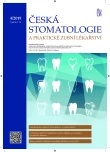-
Medical journals
- Career
Prosthetic restoration of missing upper canine, In the case of buccaly tilted implant
Authors: J. Staněk 1; R. Pink 2; M. Hammal 1; I. Voborná 1; B. Azar 1,2
Authors‘ workplace: Klinika zubního lékařství, Lékařská fakulta Univerzity Palackého a Fakultní nemocnice, Olomouc 1; Klinika ústní čelistní a obličejové chirurgie, Lékařská fakulta Univerzity Palackého a Fakultní nemocnice, Olomouc 2
Published in: Česká stomatologie / Praktické zubní lékařství, ročník 119, 2019, 4, s. 112-117
Category: Case Report
Overview
Introduction and aim: The missing tooth in the upper anterior zone is both aesthetically and functionally demanding. Patients extremely seek a satisfactory aesthetic and functional treatment. The solution can easily be complicated by a number of factors such as space closure or vestibular bone resorption.
The aim of this paper is to briefly outline and show the issue of prosthetic tooth replacement by implant in the anterior zone. Particular attention is paid to the pitfalls and possibilities of treatment by implant-retained prosthesis. In this broad issue, there is a debate on indications of cementation of these prosthesis, and also a solution to the poor placement of the implant in the anterior zone.
Methods, material: This case report focuses on the possibility of replacing a missing upper canine and describes in detail the individual clinical steps of the procedure in the fabrication of screw-retained crown on angled abutment. The protocol for impression making for a provisional crown, an individual impression for the definitive crown and the crown delivery is described. The discussion is focused on planning of the prosthesis, possible risks and their prevention and important points in decision making during planning, where the greatest emphasis is placed on the decision between the cemented and screw-retained prosthesis. Various alternatives for avoiding cemented restoration on dental implants are mentioned.
Conclusion: The reason for our decision is to maximize the health of periimplant tissues, which differ from the biological width of the natural tooth both in height, histology, and in vascularity. In the vicinity of the dental implant there are multiple collagen fibers parallel to the implant axis with low adherence to the implant neck. The soft tissue around the implant is thus similar to a scar. Its stability is essential and is determined by multiple factors: tissue phenotype, width of the labial wall of the alveolar ridge, the height of the alveolar ridge and the margins of the prosthesis.
Keywords:
implant – missing canine – screw-retained crown – cemented crown
Sources
1. Elaskary A. Periimplant tissue stability. In Elaskary: Advances in esthetic implant dentistry. 1. vydání. John Wiley & Sons; 2019, 137–139.
2. Chiapasco M, Zaniboni M. Clinical outcomes of GBR procedures to correct peri-implant dehiscences and fenestrations: a systematic review. Clin Oral Implants Res. 2009; Suppl. 4 : 113–123.
3. de Oliveira RR, Novaes AB Jr, Papalexiou V, Muglia VA, Taba M Jr. Influence of interimplant distance on papilla formation and bone resorption: a clinical-radiographic study in dogs. J Oral Implantol. 2006; 32(5): 218–227.
4. Dong J, Ikebe K, Gonda T, Nokubi T. Influence of abutment height on strain in a mandibular overdenture. J Oral Rehabil. 2006; 33(8): 594–599.
5. Jung RE, Pjetursson BE, Glauser R, Zembic A, Zwahlen M, Lang NP. A systematic review of the 5-year survival and complication rates of implant-supported single crowns. Clin Oral Implants Res. 2008; 19(2): 119–130.
6. Cardaropoli D, Debernardi C, Cardaropoli G. Immediate placement of implant into impacted maxillary canine extraction socket. Int J Periodontics Restorative Dent. 2007; 27(1): 71–77.
7. Auroy P, Lecerf J. Prosthetic restoration of the canine. J Dentofacial Anom Orthod. 2010; 13 : 112–132.
8. Wittneben JG. Screw retained vs. cement retained implant-supported fixed dental prosthesis. Periodontol. 2000. 2017; 73(1): 141–151.
9. Thoma DS, Wolleb K, Bienz SP, Wiedermeier D, Hämmerle CH, Sailer I. Early histological, microbiological, radiolo-gical and clinical response to cemented and srew-retained all-ceramic single crowns. Clin Oral Implant Res. 2018; 29(10): 1–11.
10. Lopes ACO, Machado CM, Bonjardim LR. The effect of CAD/CAM crown material and cement type on retention to implant abutments. J Prosthodont. 2019; 28(2): 552–556.
11. Strub JR, Kern M, Türp JC, Witowski S, Heydecke G, Wolfart S. Protetika III. 4. vydání. Praha: Grada Publishing, 2016 : 914–920.
12. Raval NC, Wadhwani CPK, Sumita J, Darveau RP. The interaction of implant luting cements and oral bacteria linked to peri–implant disease: an in vitro analysis of planktonic and biofilm growth – a preliminary study. Clin Implant Dent Res. 2014; 17(6): 1029–1035.
13. Wadhwani CPK. Complications related to cemented implant restoration. Dental implant complications. Wiley Online Library, 2015.
14. Astasov-Frauenhoffer M, Glauser S, Fischer J, Schmidli F, Waltimo T, Rohr N. Biofilm formation on restorative materials and resin composite cements. Dent Mater. 2018; 34(11): 1702–1709.
15. Izadi A, Heidari B, Roshanaei G, Allahbakhshi H, Fotovat F. Comparative study of dimensional accuracy in three dental implant impression techniques: open tray, closed tray with impression coping, and snap cap. J Contemp Dent Prac. 2018; 19(8): 974–981.
16. Sarment DP, Misch CE. Diagnostic casts and surgical templates. In: Misch CE. Contemporary implant dentistry. 3. vydání. St. Luise: Mosby Elsevier; 2008, 279–283.
17. Sakamoto S, Ro M, Al-Ardah A, Goodacre C. Esthetic abutment design for angulated screw channels: A technical report. J Prosthet Dent. 2018;119(6): 912–915.
Labels
Maxillofacial surgery Orthodontics Dental medicine
Article was published inCzech Dental Journal

2019 Issue 4
Most read in this issue- ORAL LICHEN PLANUS – CURRENT POINT OF VIEW
- Prosthetic restoration of missing upper canine, In the case of buccaly tilted implant
Login#ADS_BOTTOM_SCRIPTS#Forgotten passwordEnter the email address that you registered with. We will send you instructions on how to set a new password.
- Career

